Affiliate disclosure: This post may contain affiliate links. Please see our Privacy Policy.
Lion’s Mane Mushrooms (Hericium Erinaceus) are both a delicious edible mushroom and a potent medicinal. Add in the fact that they’re easy to identify and abundant in the woods, and you’ve pretty much got the perfect wild mushroom.
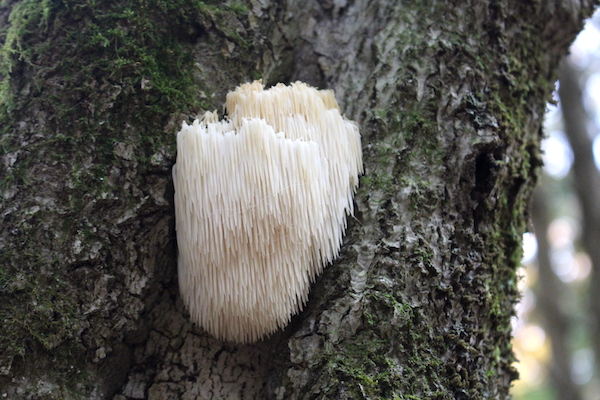
A foolproof mushroom, lion’s mane mushrooms have no look-alikes. Once you spot a cluster of icicles hanging from a dead or dying hardwood, you’re in for a real treat.
As an edible mushroom, lion’s mane has a mild seafood flavor, a bit similar to lobster. They absorb flavors (and liquid) like a sponge, which makes them versatile in cooking. While they’re a delicious edible, their real value comes from their medicinal properties.
Lion’s mane is commonly cultivated and sold for it’s purported cognitive healing benefits. Clinical trials are evaluating it as a treatment for Alzheimer’s and dementia, as well as a number of other neurodegenerative diseases.
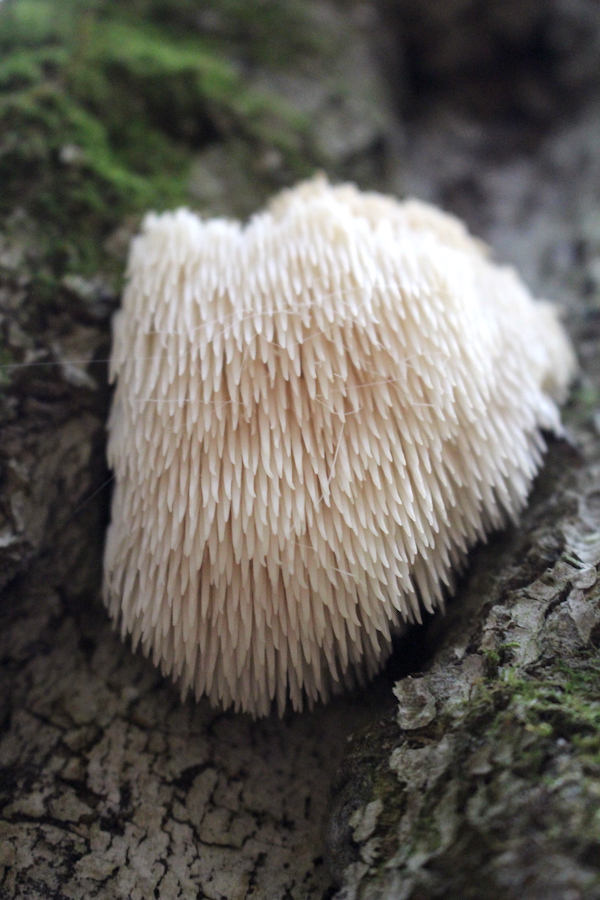
Lion’s Mane Mushroom Identification
When I say lion’s mane mushrooms have no look-alikes, I’m always surprised by what people optimistically ID in the woods. Mushrooms identification groups are full of foragers pulling any grey-ish mushroom of the ground in the spring, and optimistically asking “Is this a morel mushroom?”
Take your time, consult multiple sources and be sure of your ID before consuming any wild edible, even foolproof ones like Lion’s Mane mushrooms.
There are several species of Hericium referred to as lion’s mane’s, and they’re all used interchangeably. Hericium Erinaceus is commonly cultivated, but in the wild species include H. abietis, H. alpestre, H. americanum, H. coralloides and H. laciniatum.
It can actually be difficult to distinguish between species, even for experienced mushroom foragers. Luckily that’s not important (unless you really want to nerd-out on mushroom and get super detailed for your own entertainment).
Some species can actually only be distinguished by gene sequencing. Other’s are more obvious, and forager chef has great pictures of a number of different species if you’d like to try to pin yours down.
Regardless of the species, they’re generally white in color, sometimes tinged with yellow or pink. Some specimens start out with a pink tinge, only to mature to a whiter color. As the mushrooms age, they’ll yellow and discolor until they’re a faded orange when past prime.
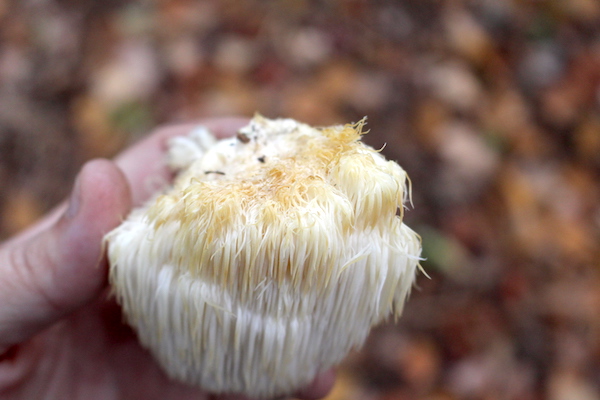
The main way to identify lion’s mane mushrooms is by the icicle-like teeth hanging from a central stalk. While they start off relatively short, the teeth grow to be over 1 centimeter long, sometimes much longer.
If you open a mature lion’s mane mushroom, you’ll find that there’s little body to speak of and it’s just a large cluster of icicle-like mushroom teeth.
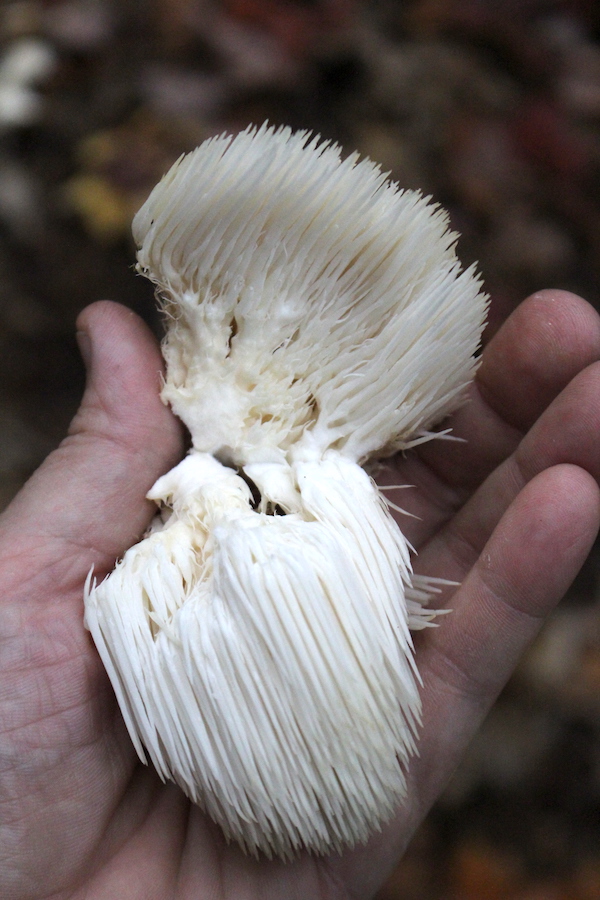
Lion’s Mane Mushroom Spore Print
Since lion’s mane has no look-alikes, I wasn’t intending to do a spore print. I happened on one walking near my house with the kids, plucked it off and came inside to set it on a plate before going back out to finish our game of hide and seek.
A few hours later when I came back in there was a nice white spore print on the black plate. Notice also that the mushroom had already started to degenerate at room temperature. These are cool-weather mushrooms, and while it was happily growing outdoors in our 40 degree autumn days, just a few hours at indoor room temperature caused it to start browning.
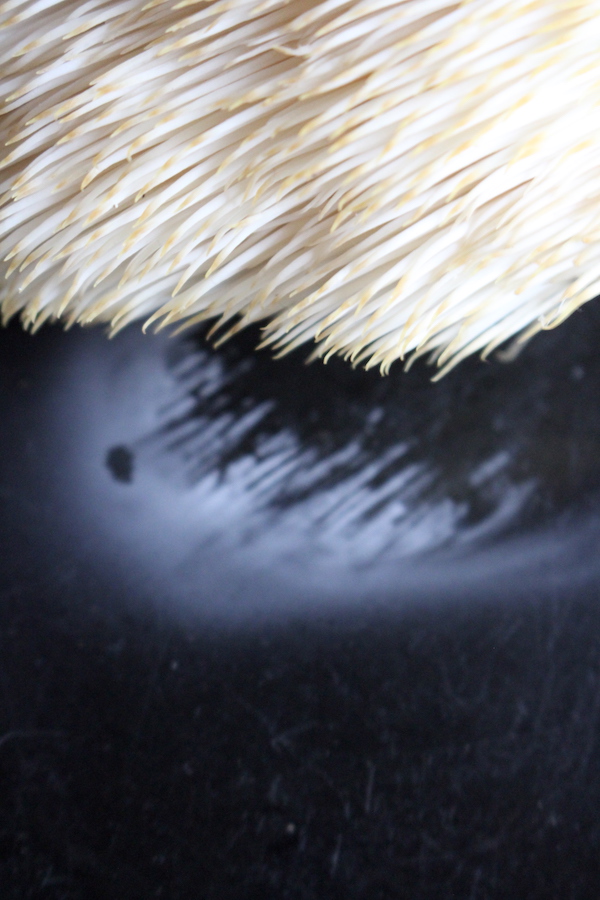
Lion’s Mane Mushroom Host Trees
What trees do lion’s mane mushrooms grow on? While they’re most commonly found on beech trees (around here anyway), they readily grow on just about any hardwood species including oak, maple, and beech.
Hericium species will attack and kill host trees, growing first on the dying wood, and then on the dead and downed logs. I’ve read that others only grow on dead wood as decomposers and do not attack living trees. Thus far, I’ve only found them on living beech trees that were severely weakened by beech canker.
We spend a lot of time in our woods in September and October foraging beech nuts. Trees infected with beech canker tend to produce empty nut husks since they’re weakened and cannot muster the energy for a good wild nut crop.
While they may not produce tasty nuts, they are an excellent place to forage lion’s mane mushrooms.
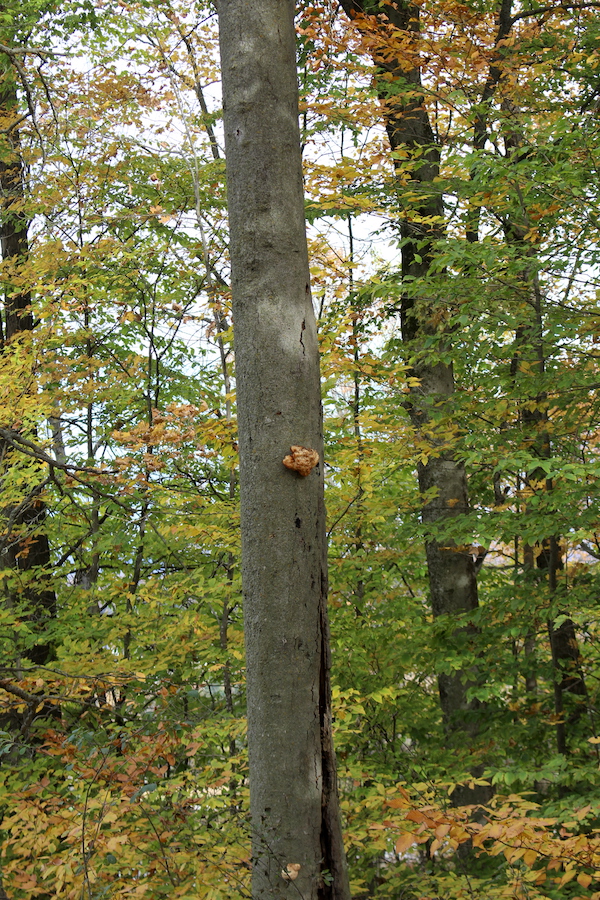
When to Find Lion’s Mane Mushrooms
The season for lion’s mane mushrooms will largely depend on your climate. They’re a cool-weather mushroom, and here in Vermont, they’re common in foliage season. September through mid-October is a good time to find them, and their season tapers off when we start having hard frosts (around 20 degrees F) in mid to late October.
I’ve read those milder climates can harvest these into December, and occasionally through the winter into February.
Here in the north country, they’re a nice splash of color on roadside trees when the hillsides are alive with fall color.
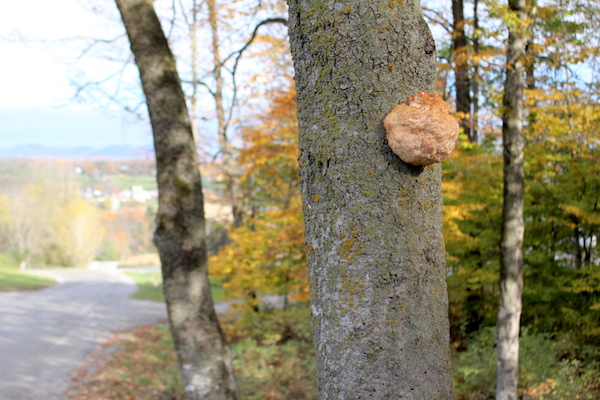
Where to Find Lion’s Mane Mushrooms
Sources conflict about the relative abundance of Hericium species. Some claim they’re “rare medicinals” while others note they’re relatively common, provided you know where (and how) to look.
Around these parts, lion’s mane mushrooms are relatively common. We have a lot of beech trees, as well as other host trees and with a keen eye, you can spot them easily in season.
The trick is…wait for cool weather, and look up!
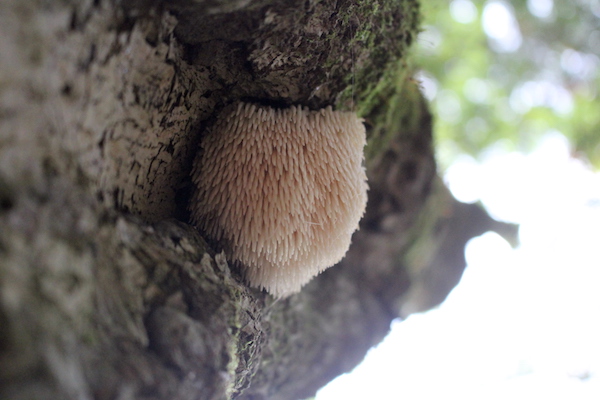
While many mushrooms grow on the ground, or near the ground at the base of trees, lion’s mane mushrooms are often found much higher.
If you want to find lion’s mane mushrooms, you’ll have to look up along the trunks of host trees. Sometimes they’ll be 40+ feet in the air which doesn’t much help a mushroom forager. The fact that they are often growing on dead or dying trees also makes it hard to even consider climbing the tree for your prize.
Still, if you spot them out of reach one year, come back later in the season (or the following year) and hopefully the tree will gift you with a few within reach.
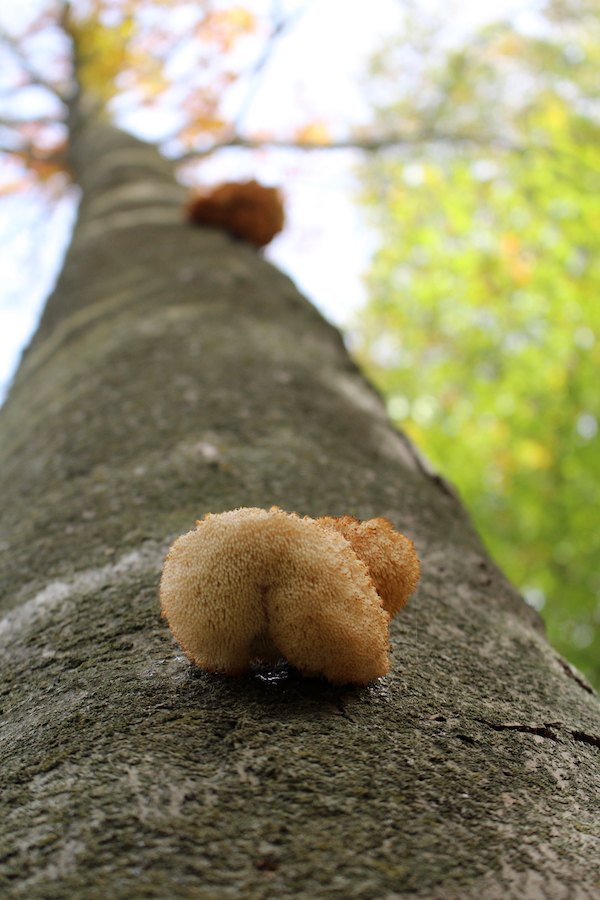
Lion’s Mane Mushroom Benefits
Around these parts, lion’s mane mushrooms are common enough at farmer’s market booths as a tasty fall edible. Most of the world knows of lion’s mane mushrooms as a medicinal mushroom with a number of promising compounds.
There are a number of recent studies suggesting that Hericium erinaceus may have many different medicinal benefits:
Regulation of blood sugar and cholesterol for diabetics
Lion’s mane mushroom extract significantly lowered blood sugar and cholesterol in diabetic lab rats, and the effect was more pronounced at higher doses. Does of 20mg/kg and 100 mg/kg were tested and the higher dose was significantly more effective at regulating both blood sugar and cholesterol. (Source)
Another study found that doses of 200 mg/kg substantially reduced blood cholesterol numbers in lab rats.
Cognitive Regeneration for Altheimer’s Disease
The current research suggests that substances that can induce the growth and regeneration of nerves, known as nerve growth factors (shortened as NGF), “are expected to be applied to the treatment of neurodegenerative diseases such as Alzheimer’s disease….H. erinaceus contains active compounds that stimulate NGF synthesis. (Source)”
A double-blind placebo trial of 50 to 80-year-old individuals with mild cognitive impairment showed significant improvement in cognitive function tests, but the effects dissipated about 4 weeks after supplementation ended.
“The subjects…took four 250 mg tablets containing 96% [lion’s mane mushroom] dry powder three times a day for 16 weeks. After termination of the intake, the subjects were observed for the next 4 weeks. At weeks 8, 12 and 16 of the trial, the [lion’s mane] group showed significantly increased scores on the cognitive function scale compared with the placebo group. The [lion’s mane] group’s scores increased with the duration of intake, but at week 4 after the termination of the 16 weeks intake, the scores decreased significantly. (Source)”
The mechanism for this is interesting because it seems that though these compounds are known to improve cognitive function, it’d be difficult to manufacture usable NGF compounds. “NGFs are proteins and so are unable to cross the blood–brain barrier…[but] research has been carried out on low-molecular-weight compounds that promote NGF biosynthesis.” Lion’s mane mushrooms seem a promising source of these low molecular weight compounds, that are small enough to cross the blood-brain barrier and have a tangible impact on cognitive function (Source).
Treatments for Depression and Anxiety
Given that lion’s mane mushrooms have been shown to stimulate nerve growth factors in the brain, scientists decided to study whether or not they’d also improve mood as a result. A placebo-controlled study showed that the lion’s mane mushroom improved concentration and lowered irritability and anxiousness in the study participants. The study concluded that lion’s mane may have applications for the treatment of depression and anxiety, as compared to placebo results. (Source)
Cancer Treatments for Drug-Resistant Carcinoma
“It has been demonstrated that the Hericium erinaceus (HE) mushroom…possesses anti-tumor activities….[and] serves as an effective tool for treating drug-resistant human hepatocellular carcinoma. (Source)”
Lion’s Mane Mushroom Supplements
Given the science behind the medicinal benefits of lion’s mane mushrooms, it’s no wonder that they’re now available in supplement form. Mushroom powder supplements, in particular, have been involved in various studies demonstrating the medicinal benefits of lion’s mane mushrooms.
Host Defense makes a lion’s mane mushroom capsule that contains 275 mg tablets. They suggest a dosage of 2 tablets per day on an ongoing basis. That said, studies in cognitive regeneration used much higher doses.
One study suggested 1000 mg taken 3 times per day (3000mg per day total). That’s about 10-12 capsules per day, which is much higher than the dosage recommended by the manufacturer.
They also make a lion’s mane mushroom powder that contains 875 mg per 1/2 tsp. This form is a bit less convenient than capsules but it seems more reasonable if you’re going to try to take the high doses used in the peer-reviewed studies.
I recently won a raffle drawing for a bottle of Host Defense Daily Immune Support, which is another supplement that contains lion’s mane mushrooms (along with 6 other medicinal mushrooms). The two capsules suggested dose contains 143 mg of lion’s mane, along with a similar amount of other medicinal mushrooms such as reishi and chaga.
For me, as an adult in my 30’s this seems like a great prophylactic dose. I do have a family history of Alzheimer’s, and with two young kids in the house, I can use all the immune-boosting I can get. I’ve been pretty happy with it, and I’ll likely re-up once my free raffle bottle is empty.
Lion’s Mane Mushroom Recipes
Mushroom supplements aside, if you do manage to find lion’s mane mushrooms in the woods, eating your medicine is a great way to go. Lion’s mane mushrooms are known as the “Lobster of the Woods” because they have a mild seafood-like taste when cooked, and they can be used as a vegan seafood substitute in all manner of recipes.
My friend Devon just released a cookbook called The Herbalists Healing Kitchen which contains a number of recipes for using food as medicine, and it includes a Lion’s Mane Mushroom Risotto in the cognitive health section. Check out the book, but if you’re just interested in making a quick risotto, you can substitute lion’s mane mushrooms for chanterelles in my recipe for chanterelle risotto.
This simple recipe for roasted lion’s manes makes for a lovely presentation and is a great way to use them as the main dish of a nourishing meal. I’m also particularly excited about these lion’s mane mushroom cakes that use this tasty mushroom as a substitute for seafood in traditional crab cakes.
For a smaller plate, these steamed lion’s manes with drawn butter really play up the lobster-like flavor and would make a lovely sampling plate appetizer.
Those are just ideas, but I’d really love to know…how are you going to cook your wild foraged lion’s mane mushrooms?
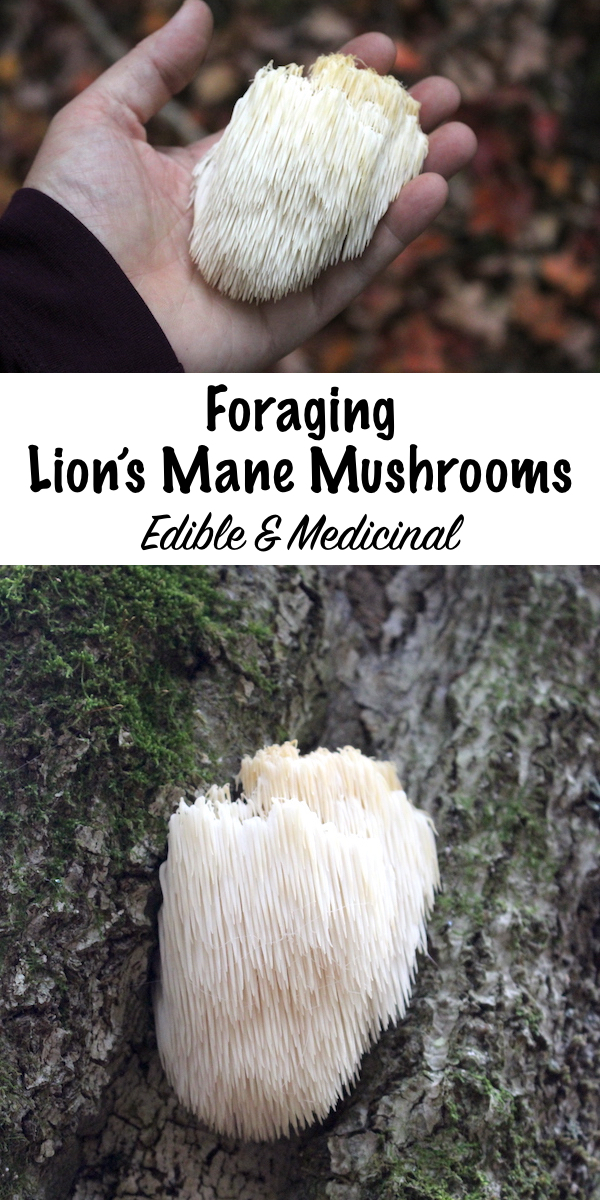

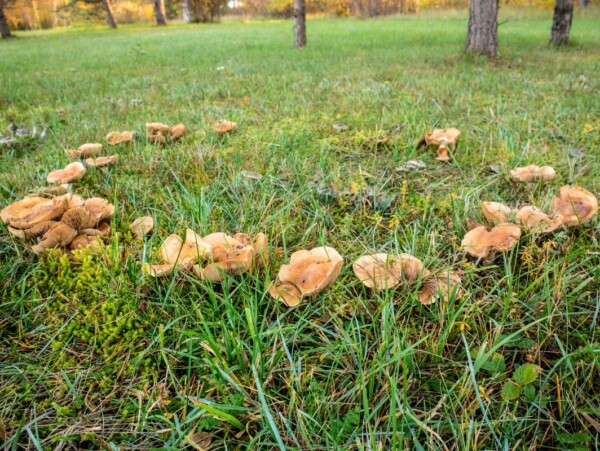
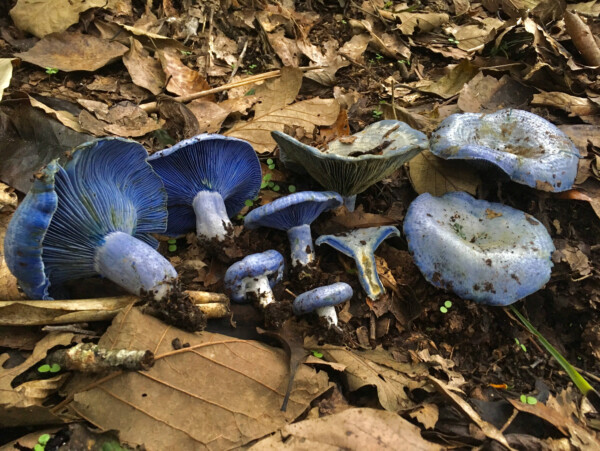
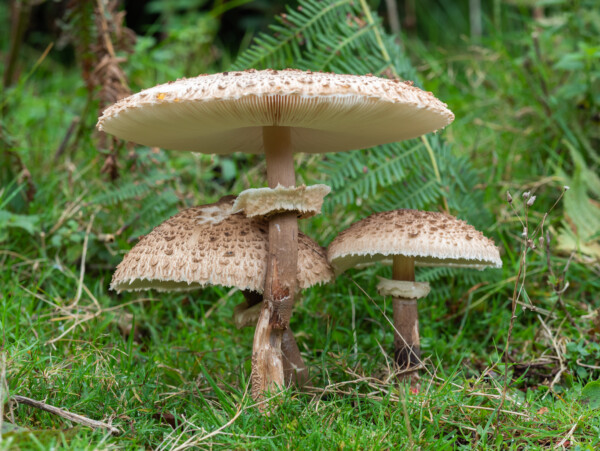
I would love to see pictures of the different types. The only ones I’ve seen were in Whole Foods and also a couple of pictures of a friend’s dinner, but they looked more like stuffed plushies with very fine “fur.”
Could you add images to the article that would show both healthy and over-the-hill versions of each type? Thanks!
If you scroll through the post you will see several pictures of mushrooms that are past their prime. Just read the descriptions under the photos and it will tell you which ones are past their prime.
I love to cook lion’s mane mushrooms! They are so delicious and healthy. I find that they are best when cooked in a skillet with some olive oil and garlic. I also like to add them to soups and stews. They are a great way to get your daily dose of antioxidants and boost your immune system. Plus, they are just so darn delicious!
Thank you for the article you wrote about lion’s mane. It was very clear and precise and easy to understand. I am new to this site, but I have been a mushroom forager since I’ve been a little girl.
I have seen many lion’s mane in my region which is Illinois, all unreachable, therefore have never tried them. however this past week end I found one small one just starting out about the size of a large plum. Normally I would leave it and let it get bigger but since I was an hour and a half away from home and have never tried them I decided to harvest that small one.
I will be trying it out tomorrow in a bit of sautéd butter with a bit of garlic and salt & pepper.
If I wanted to make medicine out of my lions mane, what would be the best way? Aqueous extract? Double extraction? TIA!
Hi Aubrey. I would probably do a double extraction following these instructions: https://blog.mountainroseherbs.com/mushroom-double-extraction
I found what I thought was lion’s mane. We cut it from the tree(leaving some there of course) when I went to looking at it and checking for identity, I noticed everything I read said it would not have much body to it. What I found looked like the pictures of lion’s mane but had a lot of body to it. Actually no airy places. Any ideas on what it could be?
Everything that I have read on the Lion’s Mane mushroom indicates that there are no look-a-likes. There are several different mushrooms within the herecium genus. They all have a similar look to them with slight differences but all of them are edible.
Love this article!! I’m doing some research for a Cookbook and I’ll include you in the references section! Thanks!!
For those who simply dehydrate the fresh and use it that way, I read somewhere that only when mushrooms are cooked do they release their benefits, and our bodies can’t absorb the ‘good stuff’ when they are consumed raw…i would assume that includes dehydration as they are not cooked…
Great information as always. I love lion’s mane and I dehydrate them and reshi and grind to a powder, mix it with cocoa for hot chocolate in the winter time–very tasty.
Such a good read! I recently tried some lions mane from a farmers market. I’ve worked in a health food store before, so I was aware of the medicinal properties, but I was so amazed at how wonderful they taste, too! I sautéed them in butter with some finely diced white onion and chicken of the woods over some couscous. They are delicious on their own, and the mushroom combo was the best!